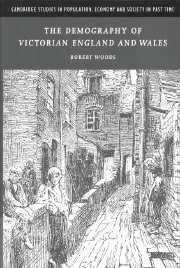Book contents
- Frontmatter
- Contents
- List of figures
- List of tables
- Preface
- 1 Bricks without straw, bones without flesh
- 2 Vital statistics
- 3 Whatever happened to the preventive check?
- 4 Family limitation
- 5 The laws of vitality
- 6 Mortality by occupation and social group
- 7 The origins of the secular decline of childhood mortality
- 8 Places and causes
- 9 The demographic consequences of urbanisation
- 10 The transformation of the English and other demographic regimes
- 11 Conclusions and unresolved conundrums
- Bibliography
- Index
- Cambridge Studies in Population, Economy and Society in Past Time
7 - The origins of the secular decline of childhood mortality
Published online by Cambridge University Press: 07 August 2009
- Frontmatter
- Contents
- List of figures
- List of tables
- Preface
- 1 Bricks without straw, bones without flesh
- 2 Vital statistics
- 3 Whatever happened to the preventive check?
- 4 Family limitation
- 5 The laws of vitality
- 6 Mortality by occupation and social group
- 7 The origins of the secular decline of childhood mortality
- 8 Places and causes
- 9 The demographic consequences of urbanisation
- 10 The transformation of the English and other demographic regimes
- 11 Conclusions and unresolved conundrums
- Bibliography
- Index
- Cambridge Studies in Population, Economy and Society in Past Time
Summary
By childhood mortality we mean the deaths of live-born infants who have not yet reached their first birthday together with children who have not reached their fifth birthday. Thus childhood mortality is the combination of infant mortality and early childhood mortality. While the infant mortality rate (IMR) did not decline substantially in England and Wales in the nineteenth century, it did enter a precipitous and sustained decline after 1899 which has continued throughout the twentieth century, but is now faltering. The early childhood mortality rate (ECMR for ages 1–4 years), on the other hand, began to decline in the middle of the nineteenth century, and certainly ECMR had parted company from IMR in the 1860s. In these circumstances the origins of the secular decline of childhood mortality become much more complicated. We shall see that the reported causes of death among infants and young children were quite dissimilar. Infants were especially vulnerable at birth and weaning, while infectious diseases such as measles, scarlet fever, whooping cough were prominent causes of death among the young children. In epidemiological terms it should not be surprising that IMR and ECMR did not follow exactly similar paths. There is also some reason to suspect that, unlike infant mortality, early childhood mortality passed through a cyclical upswing in the mid-nineteenth century and declined thereafter, and thus that some of the diseases of childhood may have been less prominent in the early years of the nineteenth century.
- Type
- Chapter
- Information
- The Demography of Victorian England and Wales , pp. 247 - 309Publisher: Cambridge University PressPrint publication year: 2000



